
Salzgitter is an independent city in southeast Lower Saxony, Germany, located between Hildesheim and Braunschweig. Together with Wolfsburg and Braunschweig, Salzgitter is one of the seven Oberzentren of Lower Saxony. With 101,079 inhabitants and 223.92 square kilometres (86.46 sq mi), its area is the largest in Lower Saxony and one of the largest in Germany. Salzgitter originated as a conglomeration of several small towns and villages, and is today made up of 31 boroughs, which are relatively compact conurbations with wide stretches of open country between them. The main shopping street of the young city is in the borough of Lebenstedt, and the central business district is in the borough of Salzgitter-Bad. The city is connected to the Mittellandkanal and the Elbe Lateral Canal by a distributary. The nearest metropolises are Braunschweig, about 23 kilometres to the northeast, and Hanover, about 51 km to the northwest. The population of the City of Salzgitter has exceeded 100,000 inhabitants since its foundation in 1942, when it was still called Watenstedt-Salzgitter. Beside Wolfsburg, Leverkusen and Eisenhüttenstadt, Salzgitter is therefore one of the few cities in Germany founded during the 20th century.
Wolfenbüttel is a district in southeastern Lower Saxony, Germany. Neighboring districts are the district-free City of Braunschweig, the district of Helmstedt, the district of Harz in Saxony-Anhalt, and the districts of Goslar, Hildesheim and Peine. The district-free city of Salzgitter cuts through the district of Wolfenbüttel in the southwest.

Goslar is a historic town in Lower Saxony, Germany. It is the administrative centre of the district of Goslar and located on the northwestern slopes of the Harz mountain range. The Old Town of Goslar and the Mines of Rammelsberg are UNESCO World Heritage Sites. Each year Goslar awards the Kaiserring to an international artist, called the "Nobel Prize" of the art world.
Lutter or Lütter may refer to:
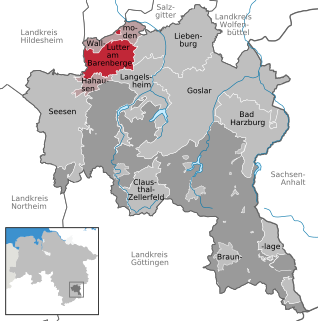
Lutter am Barenberge is a market town (Flecken) located in the Goslar district of Lower Saxony, Germany. It is the administrative seat of the Samtgemeinde Lutter am Barenberge

The Battle of Lutter took place during the Thirty Years' War, on 27 August 1626, between the forces of the Lower Saxon Circle, combining mostly Protestant states, and led by its Circle Colonel Christian IV of Denmark, and the forces of the Catholic League. Lutter am Barenberge lies to the south of the modern town of Salzgitter, then within the Imperial Circle of Lower Saxony, and now in northwest Germany.
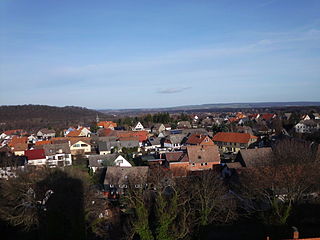
Vienenburg is a borough of Goslar, capital of the Goslar district, in Lower Saxony, Germany. The former independent municipality was incorporated in Goslar on 1 January 2014.
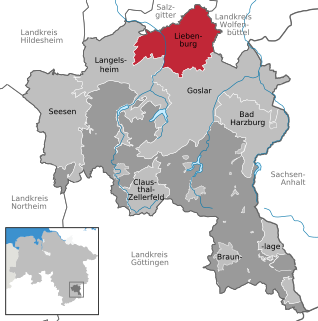
Liebenburg is a municipality in the district of Goslar, in Lower Saxony, Germany.

Altenau is a town and a former municipality in the district of Goslar, in Lower Saxony, Germany. Since 1 January 2015 it is part of the town Clausthal-Zellerfeld.

Lutter am Barenberge is a Samtgemeinde in the district of Goslar, in Lower Saxony, Germany. It is situated northwest of the Harz, approx. 13 km northwest of Goslar. Its seat is in the town Lutter am Barenberge.

The Oder is a 56-kilometre-long (35 mi) river in Lower Saxony, Germany, and a right tributary of the Rhume. Its source is in the Harz mountains, near Sankt Andreasberg. It flows southwest through Bad Lauterberg, Pöhlde and Hattorf am Harz. The Oder flows into the Rhume in Katlenburg-Lindau.

The Hildesheim Diocesan Feud or Great Diocesan Feud, sometimes referred to as a "chapter feud", was a conflict that broke out in 1519 between the Prince-Bishopric of Hildesheim and the principalities of Brunswick-Wolfenbüttel and Calenberg that were ruled by the House of Welf. Originally just a local conflict between the Hildesheim prince-bishop John IV of Saxe-Lauenburg and his own prince-bishopric's nobility (Stiftsadel), it developed into a major dispute between various Lower Saxon territorial princes. The cause was the attempt by Prince-Bishop John to redeem the pledged estates and their tax revenue from the nobles in his temporalities, the prince-bishopric. The diocesan feud ended with the Treaty of Quedlinburg in 1523.
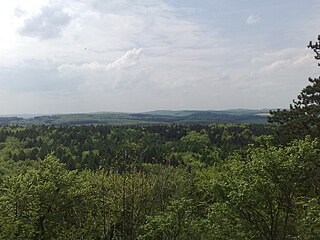
The Hainberg is a hill range, up to 299 metres high, northwest of the Harz Mountains in the eastern part of Lower Saxony, Germany.

Schladen-Werla is a municipality in the district of Wolfenbüttel, in Lower Saxony, Germany. It was formed on 1 November 2013, when the municipalities of the former Samtgemeinde Schladen: Gielde, the town of Hornburg, Schladen proper, and Werlaburgdorf were merged.
The Vienenburg–Langelsheim railway was a nearly 18-kilometer-long railway along the northern edge of the Harz in the German state of Lower Saxony. It was mainly used for freight traffic. It was opened in 1875, but it lost its importance with the closure of a line connecting to the east as a result of the division of Germany after the Second World War and it is now closed and dismantled.

The Kalte Birke is a cross tracks in the Harz Mountains of Germany where there is a refuge hut and former settlement. It is located west of the Innerste Reservoir at about 540 metres above sea level. It lies in the unparished area of Harz in the county of Goslar. Historically it is closely linked to the municipality of Hahausen and village of Neuekrug, four kilometres northwest.

Goslar is a railway station located in Goslar, Germany. The station opened on 23 March 1866 and is located on the Vienenburg–Goslar railway, Hildesheim–Goslar railway and Neuekrug-Hahausen–Goslar railway. The train services are operated by Erixx, Deutsche Bahn, and Abellio Rail Mitteldeutschland.
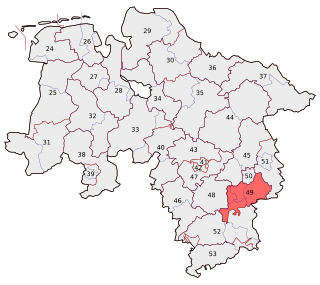
Salzgitter – Wolfenbüttel is an electoral constituency represented in the Bundestag. It elects one member via first-past-the-post voting. Under the current constituency numbering system, it is designated as constituency 49. It is located in southeastern Lower Saxony, comprising the city of Salzgitter, the district of Wolfenbüttel, and northern parts of the district of Goslar.
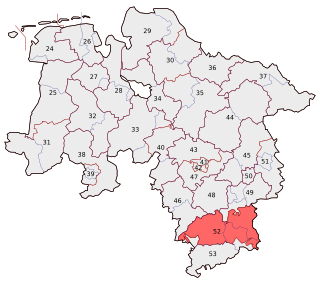
Goslar – Northeim – Osterode is an electoral constituency represented in the Bundestag. It elects one member via first-past-the-post voting. Under the current constituency numbering system, it is designated as constituency 52. It is located in southern Lower Saxony, comprising most of the districts of Goslar, Northeim, and the former Osterode.





















